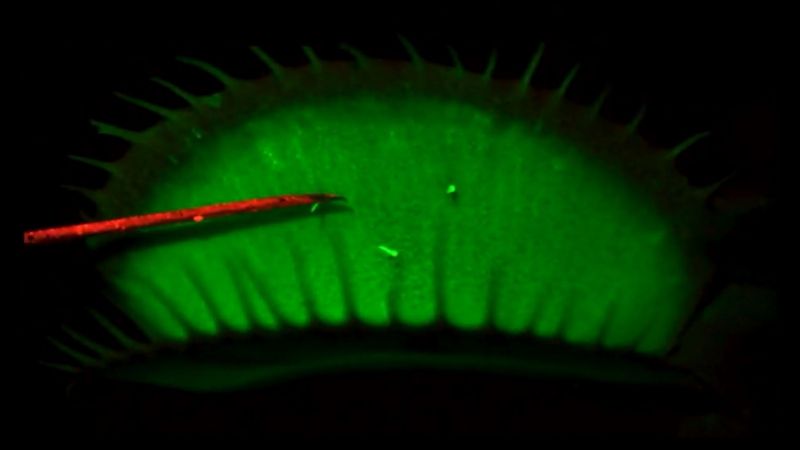As a carnivorous plant, Venus flytraps have always been a fascinating subject of study. One of their many mysteries is how they differentiate an insect visit from less nutritious stimulants such as a windblown pebble. Now scientists are one step closer to deciphering the underlying mechanism, assisted by a new ability to visualize calcium changes in real time.
Calcium has long been suspected to play an important part in a Venus flytrap’s close/no-close decision process, but scientists couldn’t verify their hypothesis before. Standard chemical tests for calcium would require cutting the plant apart, which would only result in a static snapshot. The software analogy would be killing the process for a memory dump but unable to debug the process at runtime. There were tantalizing hints of a biological calcium-based analog computer at work, but mother nature had no reason to evolve JTAG test points on it.
Lacking in-circuit debug headers, scientists turned to the next best thing: add diagnostic indicator lights. But instead of blinking LEDs, genes were added to produce a protein that glows in the presence of calcium. Once successful, they could work with the engineered plants and get visual feedback. Immediately see calcium levels change and propagate in response to various stimuli over different time periods. Confirming that the trap snaps shut only in response to patterns of stimuli that push calcium levels beyond a threshold.
With these glowing proteins in place, researchers found that calcium explained some of the behavior but was not the whole picture. There’s something else, suspected to be a fast electrical network, that senses prey movement and trigger calcium release. That’ll be something to dig into, but at least we have more experience working with electrical impulses and not just for plants, either.
















I think that if you dig deep enough, you will find the biological equivalent of a 555 timer somewhere, or maybe an arduino. :)
It,s all just signals as usual.
Grow your own arduino
Now that’s a hypothetical gardening project I could see myself working on.
The depth and sophistication of plant interactions with their environment is largely underestimated.
Take for example the way plants modulate the electric fields around their flowers to signal bees and other pollinator insects if a flower has been already visited and does not contain nectar anymore, to avoid deceiving them (and getting less chances of being pollinated).
this happens almost in real-time, while flowers provide a long-distance visual signal advertising for nectar, the electric field modulation provide individual signalling about the level of nectar in each flower.
And there are many many examples like that. Plant are just like animals that can´t move (al least most of them) and live at a very different pace :)
Plants can also signal surrounding plants of the same species when they are damaged, and the warned plants will make physical changes to help protect themselves. Maybe plants are even intelligent but just talk really, really slowly. :)
Have any links on this? – Not questioning it – just interested to learn more on it…
Oh yea I know, when someone says plants “talk” to one another your first thought it “What? How? Tell me more.” So this reference is from something half remembered I say in a documentary years ago so the best reference I can give you is the documentary I think I saw it in, here is the link.
https://curio.ca/en/video/smarty-plants-uncovering-the-secret-world-of-plant-behaviour-1443/
Good luck getting it though, it’s only available in Canada I think so you might need to use a VPN.
It’s amazing how they were designed.
Why didn’t they just use PET scanner and radioactive calcium? But the idea of a fast electrical network in the flytrap is neat, convergent evolution of a “nervous” system. And I, for one, welcome our new Triffid overlords.
Will plants ever have their own version of HIPPA?
Did anyone bother to ask this Flytrap if it wanted a picture of its privates strewn across the web?
#MeTulip ?
Seems years ago I read a Scientific American article about the 6 triggers and the logic gate of 3 or more to activate in a short time frame. Just not the chemistry in this case.